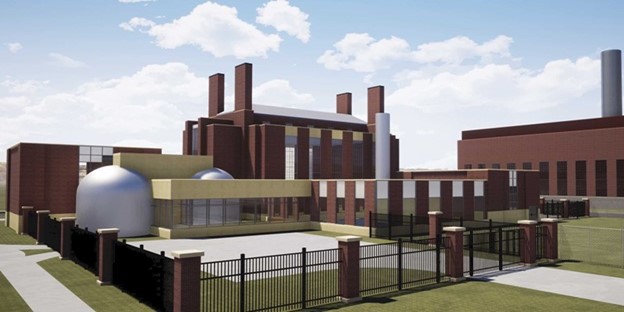A satellite image of Hawaii. Image: NASA
Jacob Wiencek, a self-described concerned resident of Honolulu, is doing his part to encourage the state of Hawaii to embrace nuclear power. An opinion piece written by Wiencek was published in Honolulu Civil Beat, an online, nonprofit news site, on August 4.
A rendering of the VTR facility. (Image: INL)
The Department of Energy announced in 2020 its approval of Critical Decision 1 for the Versatile Test Reactor (VTR) project, a one-of-a-kind scientific user facility that would support research and development of innovative nuclear energy and other technologies. The decision was well received by the nuclear energy community—after all, the DOE’s Nuclear Energy Advisory Committee had studied and reported on the need for the VTR and found strong support for the project among reactor developers, federal agencies and national laboratories, and university researchers.
The right side of the cooling tower of MIT’s reactor has the new system installed, eliminating its plume of vapor, while the untreated left side continues to produce a steady vapor stream. (Image: MIT/courtesy of the researchers)
The white plumes of steam billowing from the cooling towers of nuclear power plants and other thermal power plants represent an opportunity to some—the opportunity to collect a valued resource, purified water, that is now lost to the atmosphere. A small company called Infinite Cooling is looking to commercialize a technology recently developed at the Massachusetts Institute of Technology by the Varanasi Research Group, whose work is described in an article written by David L. Chandler, of the MIT News Office, and published on August 3.
The U.S. Department of Energy’s Kathryn Huff (at left) and the U.S. Embassy in Romania’s Chargé d’Affaires David Muniz (at right), met with Virgil Popescu, Romania’s minister of energy, on July 29.
A delegation from the Department of Energy arrived in Romania in late July to discuss bilateral energy cooperation and Romania’s expansion plans for its sole nuclear power plant, Cernavoda. The delegation was led by Kathryn Huff, acting assistant secretary and principal deputy assistant secretary for the Office of Nuclear Energy.
A shipment of transuranic waste approaches WIPP in New Mexico. (Photo: DOE)
According to the Department of Energy’s Office of Environmental Management (EM), shipments of transuranic waste to the Waste Isolation Pilot Plant in New Mexico are back to pre-pandemic levels, with the deep underground repository receiving 12 shipments in one week this summer.
A shipping cask containing high-burnup fuel rods from Dominion Virginia Power’s North Anna nuclear plant is prepared for shipment to Oak Ridge National Laboratory for study. (Photo: EPRI/Dominion Energy)
Chemist Kevin Gaddis has adapted components of a high-pressure ion chromatography system to withstand the extreme conditions of a hot cell. (Photo: ORNL/Carlos Jones)
An Oak Ridge National Laboratory researcher has built a device that can speed up the separation of the medical radioisotope actinium-225 from irradiated thorium targets and withstand the high-radiation environment of a hot cell. In July, ORNL announced that Kevin Gaddis, a chemistry technician at the lab, had built and tested a prototype and was working to secure a patent for a device that cut separations time by 75 percent.
Irradiated lead test rods are delivered to Oak Ridge National Laboratory for examination. (Photo: ORNL)
Several lead test rods of Westinghouse’s EnCore accident tolerant fuel recently arrived at Oak Ridge National Laboratory for post-irradiation examination over the next year in support of the Nuclear Regulatory Commission’s licensing process. The rods were installed in 2019 in Exelon’s Byron-2, a 1,158-MWe pressurized water reactor, and were removed in fall 2020 and prepared for shipment to ORNL.
Workers in the control room of the newly operational Honghanye-5 reactor. (Photo: Liaoning Hongyanhe Nuclear Power Company)
China continues its relentless march toward the top of the list of nations with the most power reactors. On July 31, China General Nuclear Power Group (CGN) announced that Unit 5 at the Hongyanhe plant in Liaoning Province has begun commercial operation, giving China 51 commercial-scale power reactors, only five fewer than France, which currently sits at the number-two spot on the list with 56 operating reactors.
A rendering of Ultra Safe Nuclear Corporation’s micro modular reactor as proposed for construction on the University of Illinois at Urbana-Champaign campus. (Graphic: USNC)
A bipartisan group of legislators has introduced a bill to invest in university nuclear science and engineering infrastructure, establish regional consortia to promote collaboration with industry and national laboratories, and support the development of advanced reactor technology. The National Nuclear University Research Infrastructure Reinvestment Act of 2021 (H.R. 4819) was introduced in the House of Representatives by Reps. Anthony Gonzalez (R., Ohio), Sean Casten (D., Ill.), Peter Meijer (R., Mich.), and Bill Foster (D., Ill).







 On August 4, the Clean Air Task Force (CATF) released a white paper,
On August 4, the Clean Air Task Force (CATF) released a white paper, 










